2Cool RC Plane Eric builds his 2Cool radio control biplane. | |||||||||||||||||||||||||||||||||||||||||||||||||||||||||||||||||||||||||||||||||||||||||||||||||||||||||||||||||||||||||||||||||||||||||
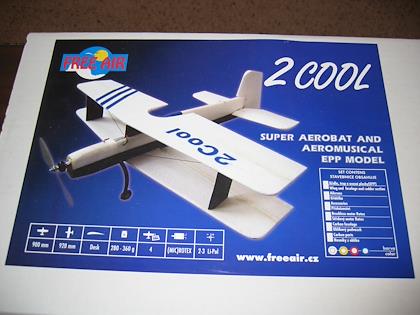 | 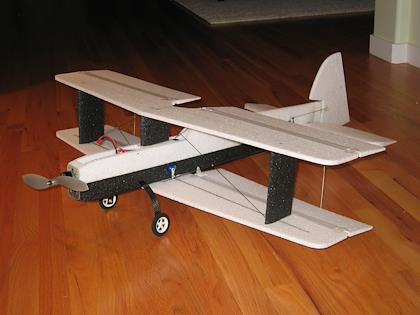 | ||||||||||||||||||||||||||||||||||||||||||||||||||||||||||||||||||||||||||||||||||||||||||||||||||||||||||||||||||||||||||||||||||||||||
| This is one of the more complex planes I've attempted to build. Seth built one and I've been using his to get ideas about the construction. I will be deviating from the instructions quite a bit. | I purchsed the kit from Northeast Sailplanes. In fact, I purchased 2 after botching the first one. It turned out that I frequently used parts from both kits to build this single plane | ||||||||||||||||||||||||||||||||||||||||||||||||||||||||||||||||||||||||||||||||||||||||||||||||||||||||||||||||||||||||||||||||||||||||
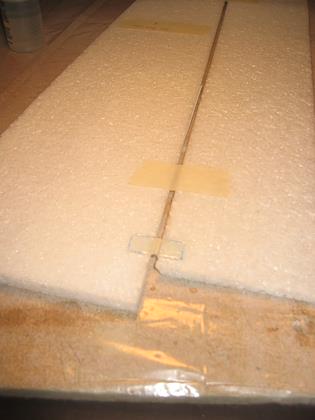 | 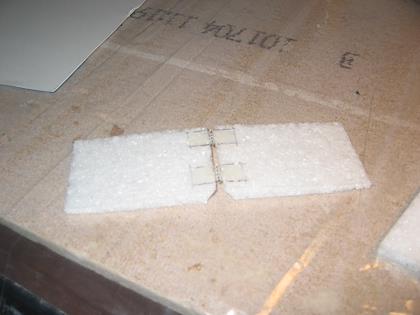 | ||||||||||||||||||||||||||||||||||||||||||||||||||||||||||||||||||||||||||||||||||||||||||||||||||||||||||||||||||||||||||||||||||||||||
| The instructions call for a simple application of tape to join the wings to the ailerons. Seth had problems at these joints where the control horns were installed. I decided that I would reinforce the edges of the joint with nylon hinges. | I first made a mock up to develop a technique for installing them. | ||||||||||||||||||||||||||||||||||||||||||||||||||||||||||||||||||||||||||||||||||||||||||||||||||||||||||||||||||||||||||||||||||||||||
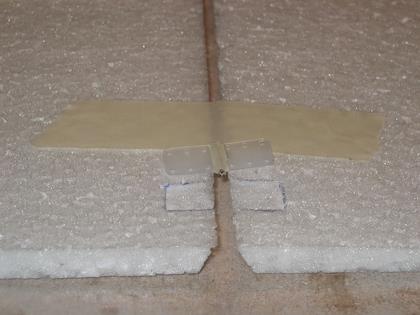 | 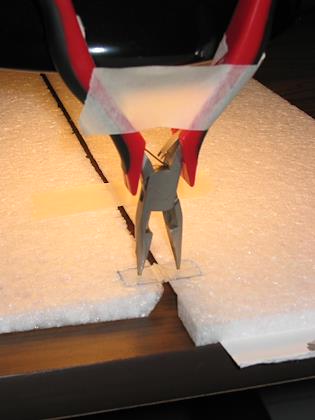 | ||||||||||||||||||||||||||||||||||||||||||||||||||||||||||||||||||||||||||||||||||||||||||||||||||||||||||||||||||||||||||||||||||||||||
| Simply trace the hinge and cut out a trough. Note the masking tape on the hinge, it keeps the epoxy from freezing the hinge. | I used 30 minute epoxy as much as possible because it does not yellow, and it gives me time to make adjustments. Here I use pliers to make sure the hinge is seated well during the setting of the epoxy. | ||||||||||||||||||||||||||||||||||||||||||||||||||||||||||||||||||||||||||||||||||||||||||||||||||||||||||||||||||||||||||||||||||||||||
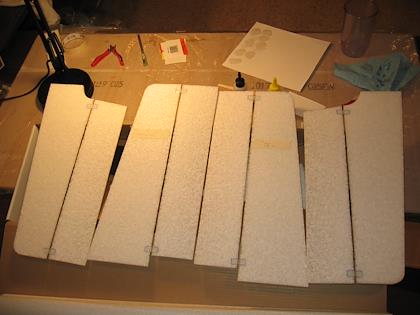 | 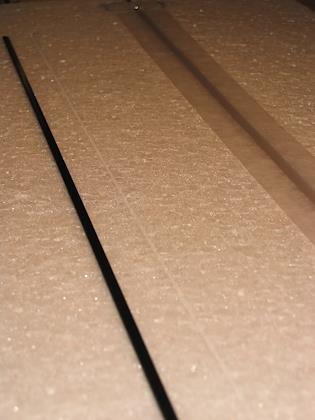 | ||||||||||||||||||||||||||||||||||||||||||||||||||||||||||||||||||||||||||||||||||||||||||||||||||||||||||||||||||||||||||||||||||||||||
| Now, do this 8 times! I was originally thinking of putting 4 hinges per aileron, but decided that that many might prove too much resistance. So, I put tape between the hinges. This turned out to work quite well. | The original kit called for a small diameter carbon rod to be installed in the wing for stiffness. I had some carbon strips leftover from another kit which would make for a much stiffer wing. | ||||||||||||||||||||||||||||||||||||||||||||||||||||||||||||||||||||||||||||||||||||||||||||||||||||||||||||||||||||||||||||||||||||||||
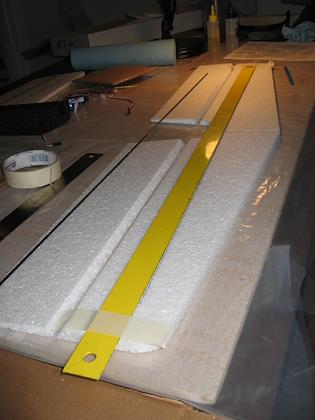 | 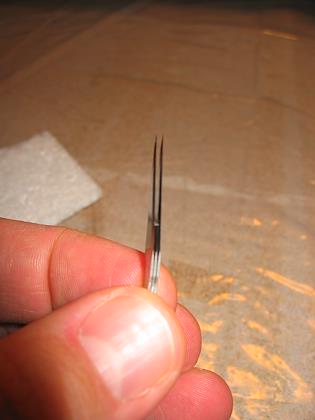 | ||||||||||||||||||||||||||||||||||||||||||||||||||||||||||||||||||||||||||||||||||||||||||||||||||||||||||||||||||||||||||||||||||||||||
| I taped a straight edge to the wing to allow me to make a good cut. | I had to cut a thin trough in which to glue the carbon strip and devised this tool: two blades separated by the handle of another. It cut a perfect trough for the strip. | ||||||||||||||||||||||||||||||||||||||||||||||||||||||||||||||||||||||||||||||||||||||||||||||||||||||||||||||||||||||||||||||||||||||||
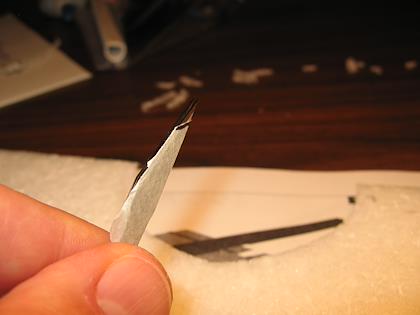 | 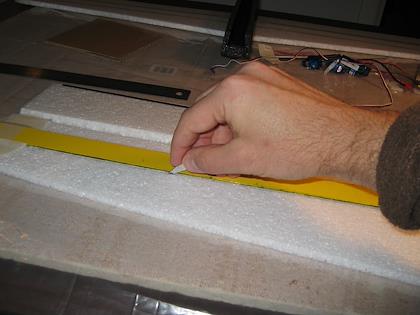 | ||||||||||||||||||||||||||||||||||||||||||||||||||||||||||||||||||||||||||||||||||||||||||||||||||||||||||||||||||||||||||||||||||||||||
| I put tape on the blade as a reference to make sure I don't cut the trough too deep. | An action shot of the cutting process. It was actually quite easy after all the setup. | ||||||||||||||||||||||||||||||||||||||||||||||||||||||||||||||||||||||||||||||||||||||||||||||||||||||||||||||||||||||||||||||||||||||||
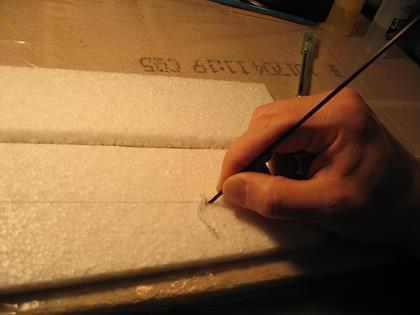 | 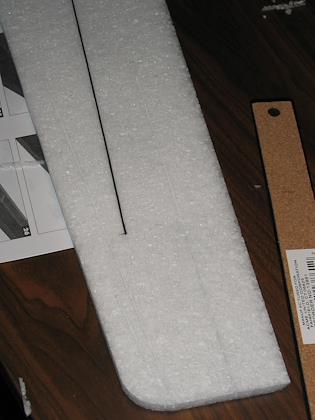 | ||||||||||||||||||||||||||||||||||||||||||||||||||||||||||||||||||||||||||||||||||||||||||||||||||||||||||||||||||||||||||||||||||||||||
| The trough EPP is dug out. I found the carbon strip to be a good digging tool. | This was actually the second kit I had bought in my attempt to build this plane. I used the first one on which to experiment construction techniques. Here you can see some cuts. | ||||||||||||||||||||||||||||||||||||||||||||||||||||||||||||||||||||||||||||||||||||||||||||||||||||||||||||||||||||||||||||||||||||||||
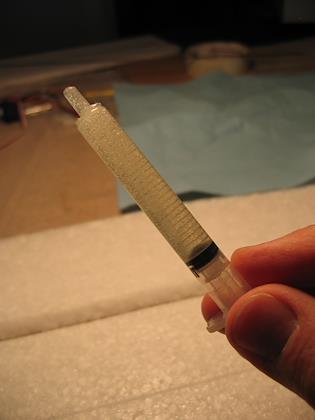 | 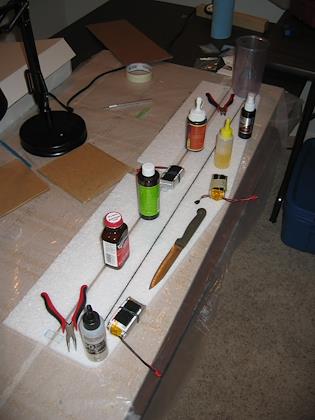 | ||||||||||||||||||||||||||||||||||||||||||||||||||||||||||||||||||||||||||||||||||||||||||||||||||||||||||||||||||||||||||||||||||||||||
| I used a syringe to inject epoxy into the trough. It was a bit tricky getting it in, but applying it into the trough was a breeze. | Gotta make sure the wing is flat while the epoxy sets! | ||||||||||||||||||||||||||||||||||||||||||||||||||||||||||||||||||||||||||||||||||||||||||||||||||||||||||||||||||||||||||||||||||||||||
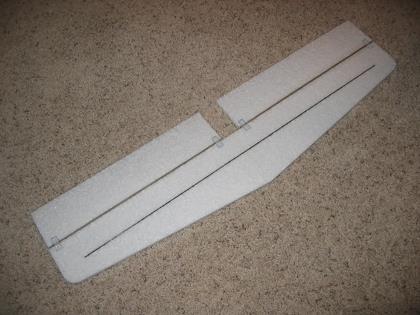 | 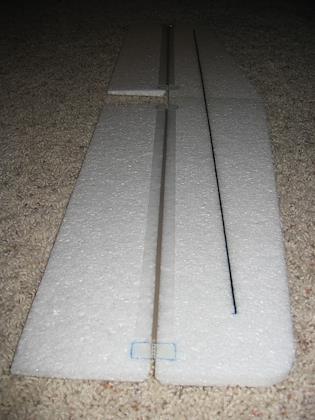 | ||||||||||||||||||||||||||||||||||||||||||||||||||||||||||||||||||||||||||||||||||||||||||||||||||||||||||||||||||||||||||||||||||||||||
| The bottom wing! Needless to day, I've probably spent more time on the wings then most spend putting the whole thing together! | Here you can see the tape which keeps the middle part of the aileron aligned with the wing. I used 3M Blemderm | ||||||||||||||||||||||||||||||||||||||||||||||||||||||||||||||||||||||||||||||||||||||||||||||||||||||||||||||||||||||||||||||||||||||||
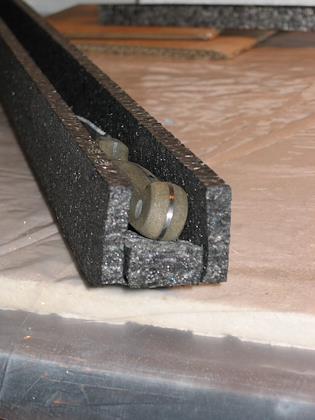 | 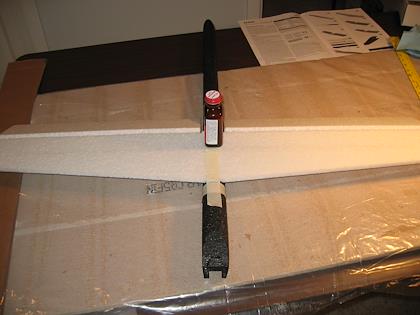 | ||||||||||||||||||||||||||||||||||||||||||||||||||||||||||||||||||||||||||||||||||||||||||||||||||||||||||||||||||||||||||||||||||||||||
| The bottom of the lower part of the fuselage needs to be reinforced. Here I glue a piece in. I will glue the sides of this piece after the bottom is set so I can place it properly. This is the nose of the plane. A fiberglass piece where the motor will be mounted will be glued here. | The I glue the bottom wing to the fuselage. It's very important to make the the wing is aligned properly, there is a lot of epoxy involved! | ||||||||||||||||||||||||||||||||||||||||||||||||||||||||||||||||||||||||||||||||||||||||||||||||||||||||||||||||||||||||||||||||||||||||
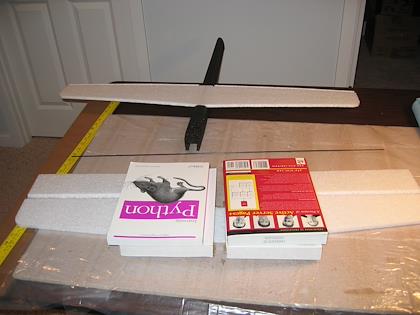 | 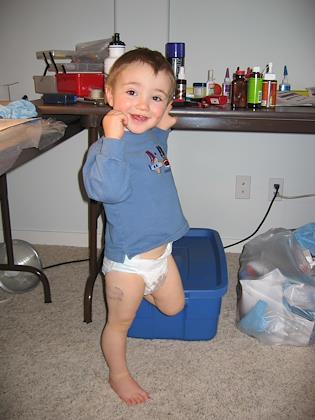 | ||||||||||||||||||||||||||||||||||||||||||||||||||||||||||||||||||||||||||||||||||||||||||||||||||||||||||||||||||||||||||||||||||||||||
| Here I glue the two halves of the upper wing together. There are two pieces of cardboard under the wings to elevate it from the table so the the epoxy around the joint does not come into contact with the table. | Kenny decides to check things out! | ||||||||||||||||||||||||||||||||||||||||||||||||||||||||||||||||||||||||||||||||||||||||||||||||||||||||||||||||||||||||||||||||||||||||
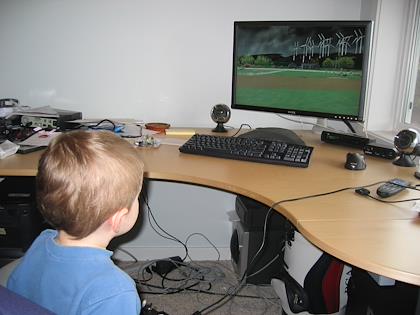 | 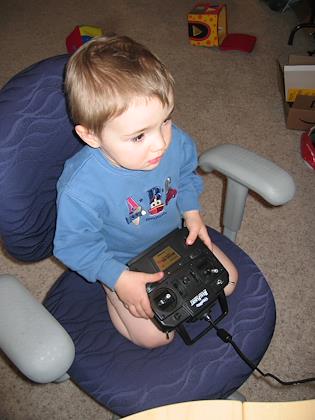 | ||||||||||||||||||||||||||||||||||||||||||||||||||||||||||||||||||||||||||||||||||||||||||||||||||||||||||||||||||||||||||||||||||||||||
| I figure it's time to let Kenny fly. But first, some time on the simulator! Note the image on the screen. It looks like the camera caught two frames. | I suppose this is his first video game! He was not so good at flying, but very good at hitting the reset button after the simulated model crashed. | ||||||||||||||||||||||||||||||||||||||||||||||||||||||||||||||||||||||||||||||||||||||||||||||||||||||||||||||||||||||||||||||||||||||||
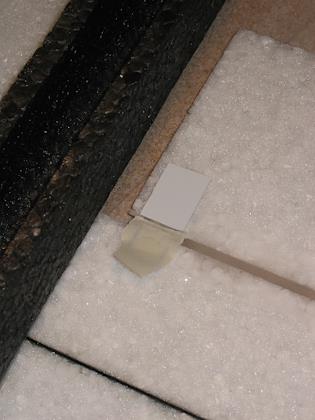 | 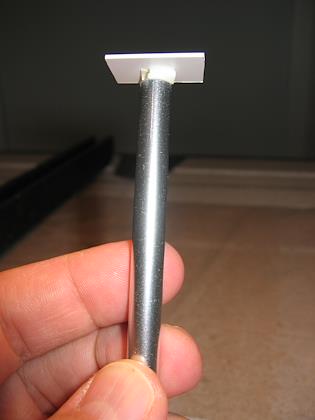 | ||||||||||||||||||||||||||||||||||||||||||||||||||||||||||||||||||||||||||||||||||||||||||||||||||||||||||||||||||||||||||||||||||||||||
| The control horns for the ailerons will mount directly on the nylon hinge, but my experience with the mock up hinges has shown me that with enough force they can be pulled off. So, I epoxy a small sheet of fairly rigid plastic to cover the hinge and the area around to form a better mounting surface for the control horn. Note masking the hinge joint is critical to making sure the epoxy does not get into it. | Again, I used my primitive tool making capacity to put the plastic pieces into place. Now, is the capacity primitive, or is the tool primitive? You decide :-) | ||||||||||||||||||||||||||||||||||||||||||||||||||||||||||||||||||||||||||||||||||||||||||||||||||||||||||||||||||||||||||||||||||||||||
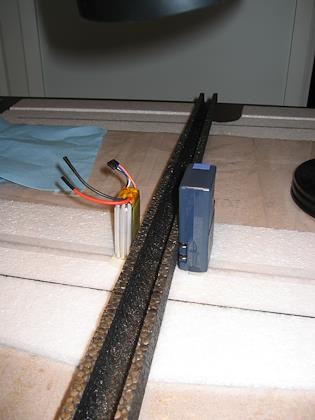 | 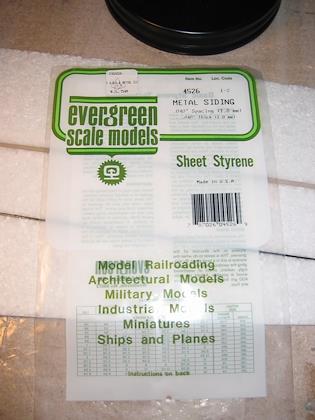 | ||||||||||||||||||||||||||||||||||||||||||||||||||||||||||||||||||||||||||||||||||||||||||||||||||||||||||||||||||||||||||||||||||||||||
| Again, I weight them down to form a nice join. | The plastic is actually Styrene which is meant to be used by model railroad hobbyists to make something look like metal siding! One side of the sheet is corrugated. This side is placed down and glued. | ||||||||||||||||||||||||||||||||||||||||||||||||||||||||||||||||||||||||||||||||||||||||||||||||||||||||||||||||||||||||||||||||||||||||
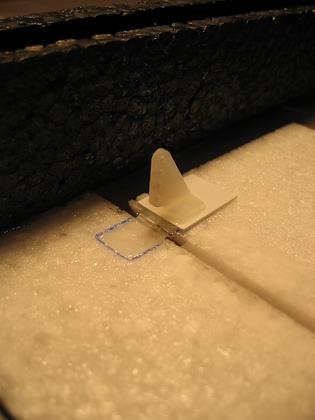 | 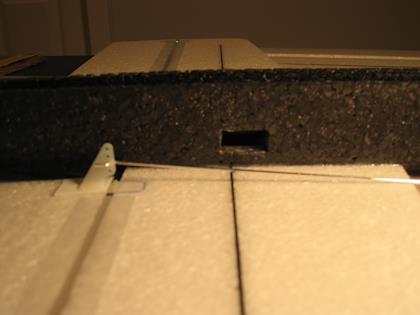 | ||||||||||||||||||||||||||||||||||||||||||||||||||||||||||||||||||||||||||||||||||||||||||||||||||||||||||||||||||||||||||||||||||||||||
| Then I epoxy the control horns to the ailerons. | I cut the holes for the aileron servos. | ||||||||||||||||||||||||||||||||||||||||||||||||||||||||||||||||||||||||||||||||||||||||||||||||||||||||||||||||||||||||||||||||||||||||
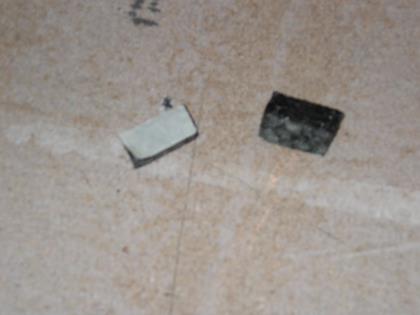 |  | ||||||||||||||||||||||||||||||||||||||||||||||||||||||||||||||||||||||||||||||||||||||||||||||||||||||||||||||||||||||||||||||||||||||||
| I used a piece of masking tape with the dimensions of the bottom of the servos. This makes placing the holes and cutting them quite easy. | They fit nicely. | ||||||||||||||||||||||||||||||||||||||||||||||||||||||||||||||||||||||||||||||||||||||||||||||||||||||||||||||||||||||||||||||||||||||||
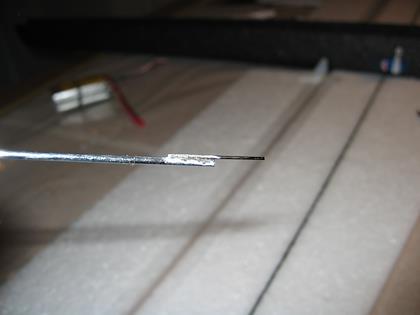 | 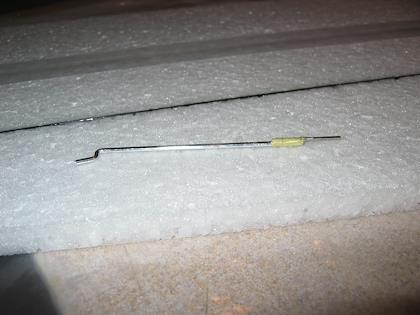 | ||||||||||||||||||||||||||||||||||||||||||||||||||||||||||||||||||||||||||||||||||||||||||||||||||||||||||||||||||||||||||||||||||||||||
| Next I make the control arms for the ailerons. They connect the servo to the control horn. The kit came with aluminum control rods with z bends already in them. They fit into the horns very nicely. I am using mini ez connectors to connect to the arm of the servo, so I use the shaft of a heavy pin. I first superglue it on. | But, the superglue (also known as CA or cyanoacrylate) is too brittle and the pin breaks off. So, I use a trick I learned when I built my | ||||||||||||||||||||||||||||||||||||||||||||||||||||||||||||||||||||||||||||||||||||||||||||||||||||||||||||||||||||||||||||||||||||||||
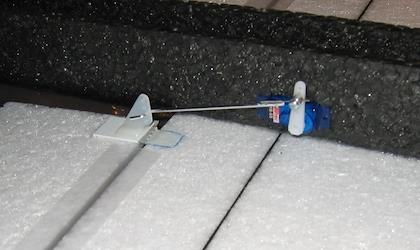 | 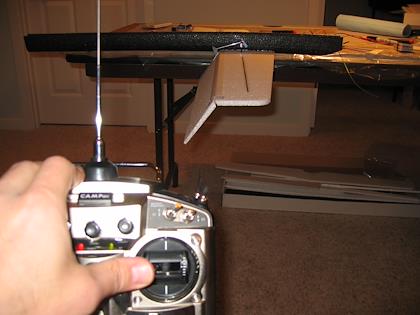 | ||||||||||||||||||||||||||||||||||||||||||||||||||||||||||||||||||||||||||||||||||||||||||||||||||||||||||||||||||||||||||||||||||||||||
| The completed control. I realize that I probably should have mounted the control arm blow the servo so that the control rod is parallel to the wing. No biggie. | Testing the aileron. | ||||||||||||||||||||||||||||||||||||||||||||||||||||||||||||||||||||||||||||||||||||||||||||||||||||||||||||||||||||||||||||||||||||||||
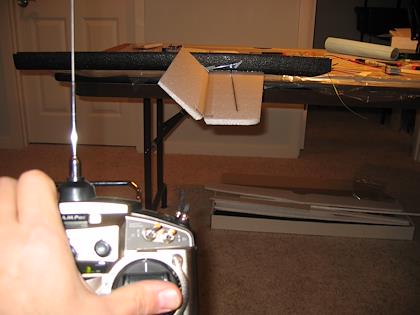 | 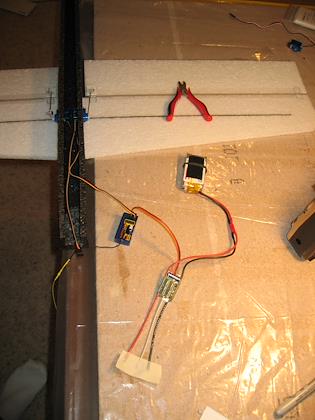 | ||||||||||||||||||||||||||||||||||||||||||||||||||||||||||||||||||||||||||||||||||||||||||||||||||||||||||||||||||||||||||||||||||||||||
| I'm using an Electron-6 receiver and Phoenix 25 motor controller. | |||||||||||||||||||||||||||||||||||||||||||||||||||||||||||||||||||||||||||||||||||||||||||||||||||||||||||||||||||||||||||||||||||||||||
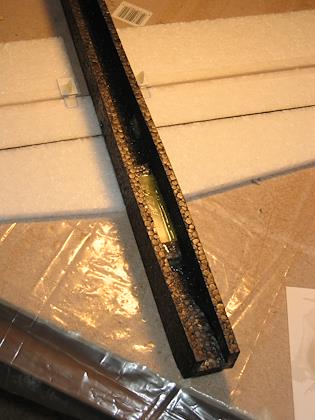 | 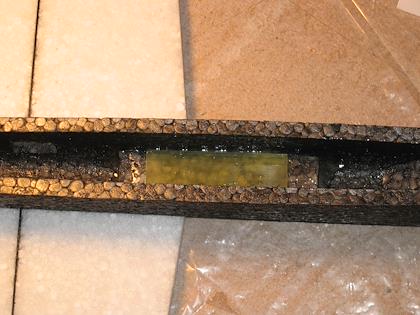 | ||||||||||||||||||||||||||||||||||||||||||||||||||||||||||||||||||||||||||||||||||||||||||||||||||||||||||||||||||||||||||||||||||||||||
| Now I am reinforcing the fuselage for the mounting of the carbon fiber landing leaf spring. I've had problems with the landing springs ripping off of previous models, and Seth's 2Cool also suffered from this problem. I figure I better make this one really sturdy. | The kit comes with a fiberglass plate which is meant to sit at the bottom the fuselage. The instructions call for the spring to be glued to the bottom of the plate. However, I cut out a piece of the inner fuselage and epoxy it into the space to provide a wide area of contact for the spring's force to be distributed. | ||||||||||||||||||||||||||||||||||||||||||||||||||||||||||||||||||||||||||||||||||||||||||||||||||||||||||||||||||||||||||||||||||||||||
 | 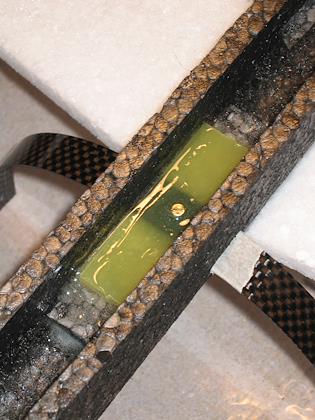 | ||||||||||||||||||||||||||||||||||||||||||||||||||||||||||||||||||||||||||||||||||||||||||||||||||||||||||||||||||||||||||||||||||||||||
| Then, I cut slits on the sides allowing the spring to be inserted and glued and screwed the two plates together. This should be a rather strong landing gear. | |||||||||||||||||||||||||||||||||||||||||||||||||||||||||||||||||||||||||||||||||||||||||||||||||||||||||||||||||||||||||||||||||||||||||
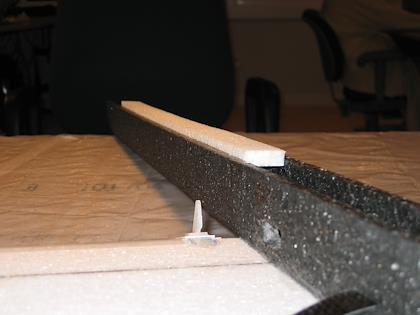 | 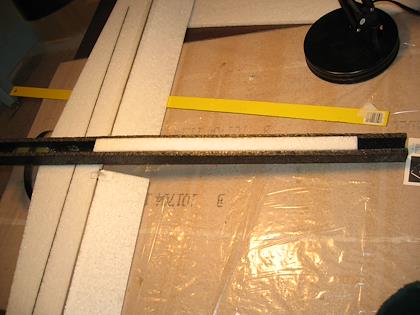 | ||||||||||||||||||||||||||||||||||||||||||||||||||||||||||||||||||||||||||||||||||||||||||||||||||||||||||||||||||||||||||||||||||||||||
| The next step is to epoxy the two halves of the fuselage together. However, I found that the top part of the fuselage was wider than the bottom, probably due to common EPP foam wackiness. So, I decided to first cut out an insert (from a wing from my first kit) and insert along where the joint will be for the two halves. This long piece is slightly wider than the upper part of the fuselage. | Now, when I glue both halves together, they will meet perfectly. Or, as close as one can get with foam. Also, this will strengthen the fuselage. Note that I CA'ed the foam strip in so that when I apply the epoxy and glue the two halves together, the strip will not slip out of place, and the CA won't have dried into a clump which would make the two hard to join, like epoxy would. | ||||||||||||||||||||||||||||||||||||||||||||||||||||||||||||||||||||||||||||||||||||||||||||||||||||||||||||||||||||||||||||||||||||||||
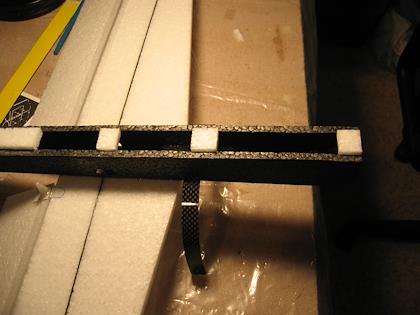 | 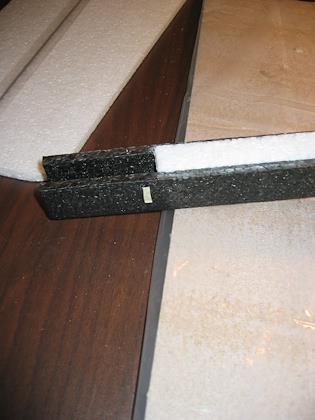 | ||||||||||||||||||||||||||||||||||||||||||||||||||||||||||||||||||||||||||||||||||||||||||||||||||||||||||||||||||||||||||||||||||||||||
| The strip to widen and match the two parts of the fuselage seemed like such a good idea that I decided to put a few more pieces in to strengthen the front. If I need to, I can cut them out later. | I marked where I thought the axle for the elevators should go. | ||||||||||||||||||||||||||||||||||||||||||||||||||||||||||||||||||||||||||||||||||||||||||||||||||||||||||||||||||||||||||||||||||||||||
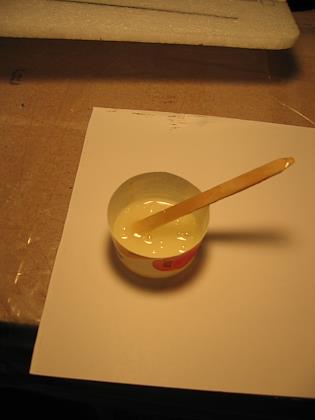 | 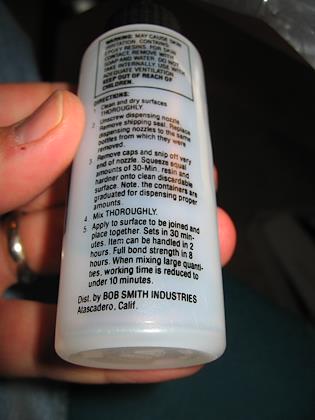 | ||||||||||||||||||||||||||||||||||||||||||||||||||||||||||||||||||||||||||||||||||||||||||||||||||||||||||||||||||||||||||||||||||||||||
| I mixed a large batch of 30 minute epoxy to glue the two parts of the fuselage together. | However, I should have read the directions a little closer, for when I was applying the epoxy, it started to set way more quickly than I expected. Note "When mixing large quantities ...". The little cup I was using got quite warm from the chemical reaction. | ||||||||||||||||||||||||||||||||||||||||||||||||||||||||||||||||||||||||||||||||||||||||||||||||||||||||||||||||||||||||||||||||||||||||
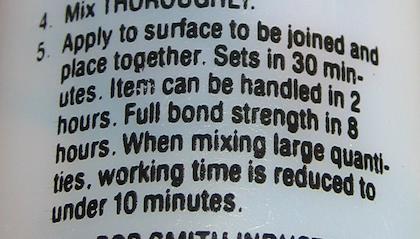 | 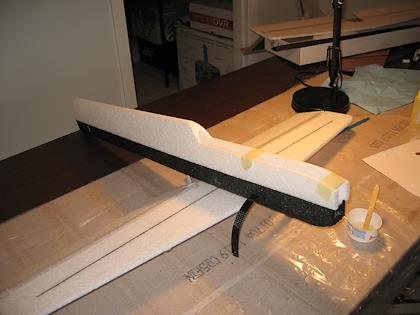 | ||||||||||||||||||||||||||||||||||||||||||||||||||||||||||||||||||||||||||||||||||||||||||||||||||||||||||||||||||||||||||||||||||||||||
| Here I let the epoxy sit. It's starting to look like a real airplane now! | |||||||||||||||||||||||||||||||||||||||||||||||||||||||||||||||||||||||||||||||||||||||||||||||||||||||||||||||||||||||||||||||||||||||||
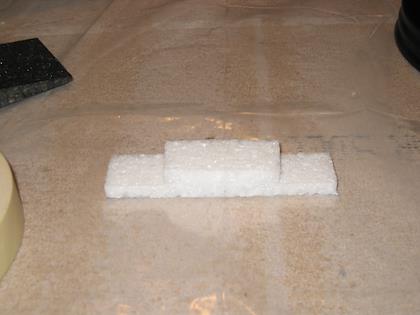 | 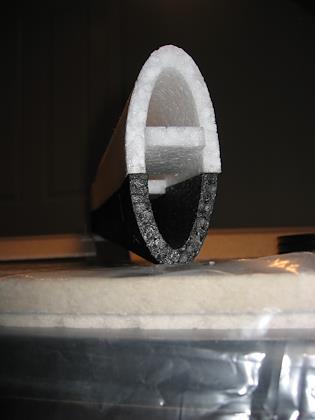 | ||||||||||||||||||||||||||||||||||||||||||||||||||||||||||||||||||||||||||||||||||||||||||||||||||||||||||||||||||||||||||||||||||||||||
| This is a piece which gets glued into the top front part of the fuselage. It will support a vertical piece which support the middle span of the upper wing. The original plans call for a single strip. Here I reinforce with with another, smaller, strip which greatly strengths the support. | Before gluing the back end of the fuselage together, I noticed than the right hand seam was not glued well. Here I re glue it. The piece in the middle is used to force the two halves of the fuselage together to form a tight seam. | ||||||||||||||||||||||||||||||||||||||||||||||||||||||||||||||||||||||||||||||||||||||||||||||||||||||||||||||||||||||||||||||||||||||||
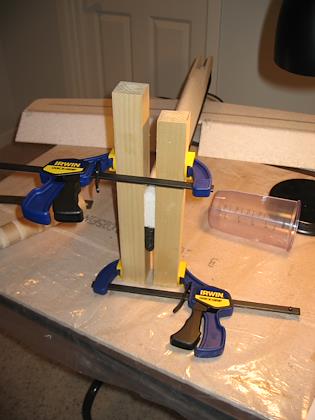 | 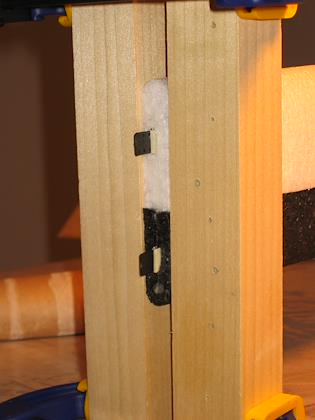 | ||||||||||||||||||||||||||||||||||||||||||||||||||||||||||||||||||||||||||||||||||||||||||||||||||||||||||||||||||||||||||||||||||||||||
| Here I glue the tail of the fuselage together. | I also glue in the hinges for the rudder. | ||||||||||||||||||||||||||||||||||||||||||||||||||||||||||||||||||||||||||||||||||||||||||||||||||||||||||||||||||||||||||||||||||||||||
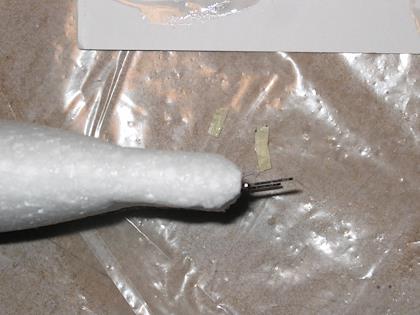 | 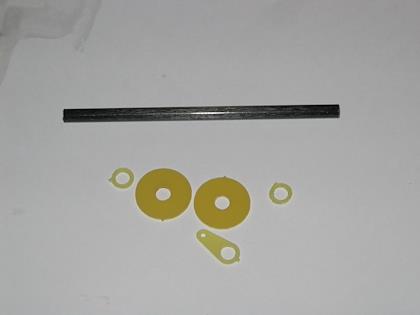 | ||||||||||||||||||||||||||||||||||||||||||||||||||||||||||||||||||||||||||||||||||||||||||||||||||||||||||||||||||||||||||||||||||||||||
| The tail is a pointed a little to the right. I thought about making a vertical cut along the fuselage, straightening the tail and putting epoxy into the gap, but decided that the bend was not much of a problem. In fact, it might make installing the control rods a bit easier. | These are the pieces which make up the axle for the elevators. The two larger washers will be epoxied to the sides of the fuselage over holes. The smaller washers will be expoxied to the tube to hold it in place. Then the control piece will be epoxied last. | ||||||||||||||||||||||||||||||||||||||||||||||||||||||||||||||||||||||||||||||||||||||||||||||||||||||||||||||||||||||||||||||||||||||||
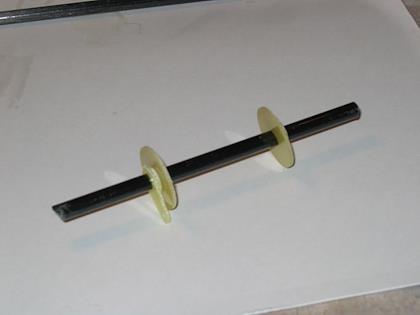 |  | ||||||||||||||||||||||||||||||||||||||||||||||||||||||||||||||||||||||||||||||||||||||||||||||||||||||||||||||||||||||||||||||||||||||||
| Sample assembly! Note that I had to enlarge the holes to accommodate the axle. | The sides of the fuselage slope towards the tail. This will causes the washers to not be perpendicular to the axle and cause binding. I cut out a circular shaped wedge which I will epoxy next to the holes to print the washers parallel to each other. | ||||||||||||||||||||||||||||||||||||||||||||||||||||||||||||||||||||||||||||||||||||||||||||||||||||||||||||||||||||||||||||||||||||||||
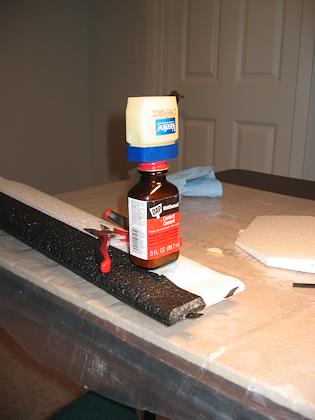 | 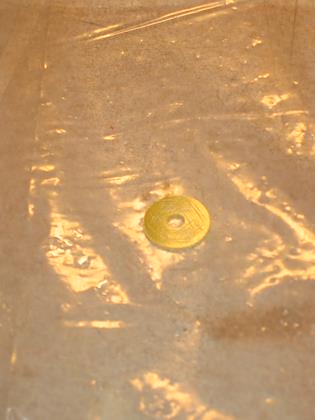 | ||||||||||||||||||||||||||||||||||||||||||||||||||||||||||||||||||||||||||||||||||||||||||||||||||||||||||||||||||||||||||||||||||||||||
| Gotta get creative when I glue the wedge to the fuselage. I want the entire wedge to make contact. | I score the side of the washer which will take the epoxy to make a better join. | ||||||||||||||||||||||||||||||||||||||||||||||||||||||||||||||||||||||||||||||||||||||||||||||||||||||||||||||||||||||||||||||||||||||||
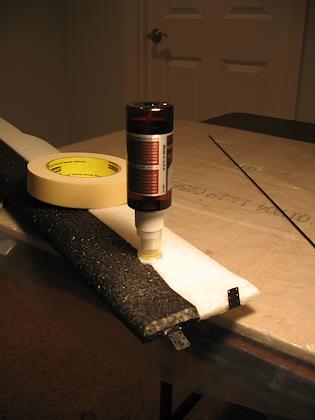 | 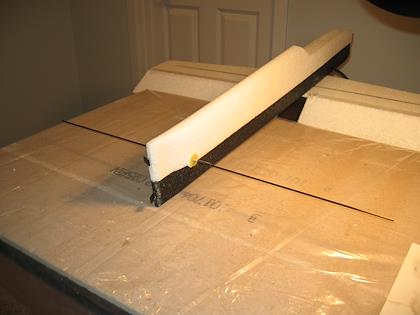 | ||||||||||||||||||||||||||||||||||||||||||||||||||||||||||||||||||||||||||||||||||||||||||||||||||||||||||||||||||||||||||||||||||||||||
| Here I'm gluing one of the larger washers to the fuselage. | I take particular care to make sure that when I glue the second washer on, the axle will be positioned properly. Here I use a long carbon rod and measure the distance to the wing to make sure it is normal to the fuselage. | ||||||||||||||||||||||||||||||||||||||||||||||||||||||||||||||||||||||||||||||||||||||||||||||||||||||||||||||||||||||||||||||||||||||||
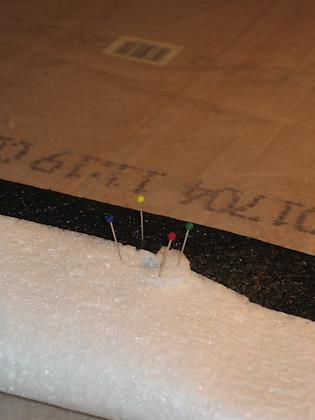 | 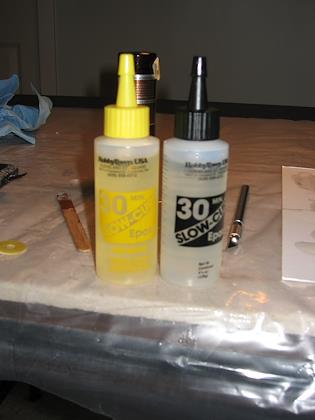 | ||||||||||||||||||||||||||||||||||||||||||||||||||||||||||||||||||||||||||||||||||||||||||||||||||||||||||||||||||||||||||||||||||||||||
| I use pins to identify the correct position because I will need to apply the epoxy with the washer facing up. If I let it dry with the washer facing a wall, the glue may run and clog the hole. | I used up my first bottle of epoxy! Luckily I have another. | ||||||||||||||||||||||||||||||||||||||||||||||||||||||||||||||||||||||||||||||||||||||||||||||||||||||||||||||||||||||||||||||||||||||||
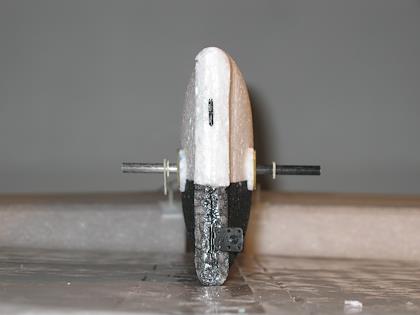 | 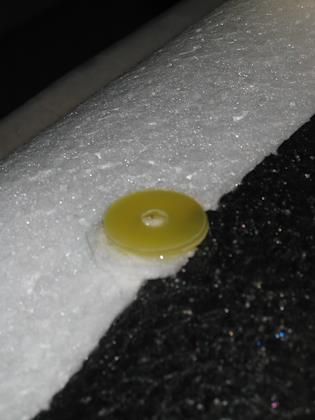 | ||||||||||||||||||||||||||||||||||||||||||||||||||||||||||||||||||||||||||||||||||||||||||||||||||||||||||||||||||||||||||||||||||||||||
| After all that care, the axle is still too low on the right. I thought about cutting the washer off, but I did not want to butcher the tail. So, I decided to change the position of the hole! | Having a second kit has come in handy again! Here I use an extra washer, offset just the right amount to correct the errors of the first. I enlarged the hold of the inner washer in the direction that the axle had to move. Before the epoxy was fully set, I adjusted the position of the new washer to be in the absolutely perfect position. | ||||||||||||||||||||||||||||||||||||||||||||||||||||||||||||||||||||||||||||||||||||||||||||||||||||||||||||||||||||||||||||||||||||||||
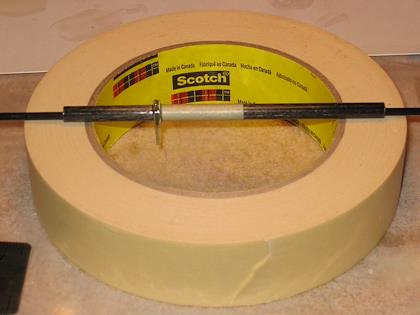 | 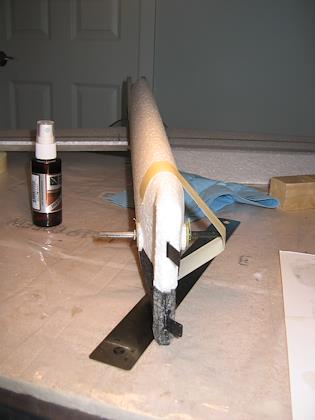 | ||||||||||||||||||||||||||||||||||||||||||||||||||||||||||||||||||||||||||||||||||||||||||||||||||||||||||||||||||||||||||||||||||||||||
| Here, I glue the control horn to the elevator axle. Gotta make sure it's perpendicular to the rod | Then I insert the axle through the large washers and glue the small washer to the other side to lock the axle in place. To make sure the rod will not slip, I tape it on the other side. | ||||||||||||||||||||||||||||||||||||||||||||||||||||||||||||||||||||||||||||||||||||||||||||||||||||||||||||||||||||||||||||||||||||||||
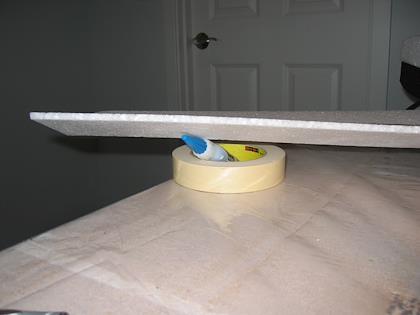 | 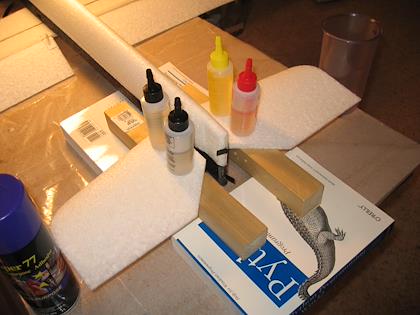 | ||||||||||||||||||||||||||||||||||||||||||||||||||||||||||||||||||||||||||||||||||||||||||||||||||||||||||||||||||||||||||||||||||||||||
| I had to level the fuselage when the last small washer was setting, as it settled into a non perpendicular position onto the rod. | Here I am gluing the elevators to the axle. I have contructed a little jig to make sure the elevator halves are inline with each other and with the fuselage. | ||||||||||||||||||||||||||||||||||||||||||||||||||||||||||||||||||||||||||||||||||||||||||||||||||||||||||||||||||||||||||||||||||||||||
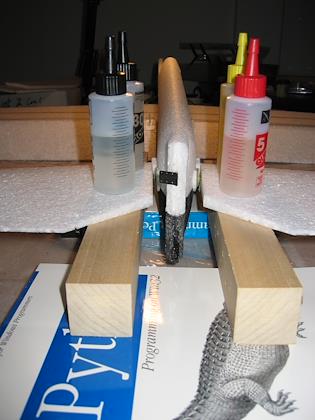 | 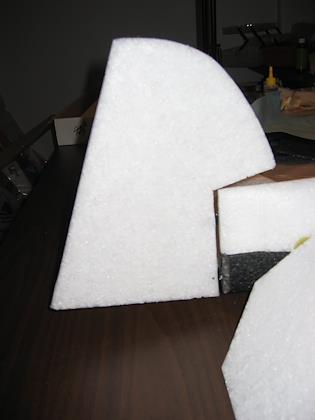 | ||||||||||||||||||||||||||||||||||||||||||||||||||||||||||||||||||||||||||||||||||||||||||||||||||||||||||||||||||||||||||||||||||||||||
| Here you can see how crooked the tail is. Fortunately, it should not affect performance, and could actually be useful in easing the installation of the rudder control rod/horn connection. | The installation of the rudder is pretty trivial. I had to flatten the narrow surface which faces the fuselage, and trim the corners of that same surface to allow for full rudder swings. | ||||||||||||||||||||||||||||||||||||||||||||||||||||||||||||||||||||||||||||||||||||||||||||||||||||||||||||||||||||||||||||||||||||||||
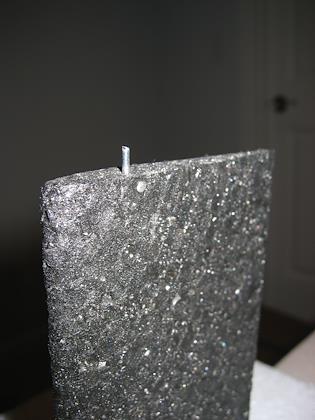 | 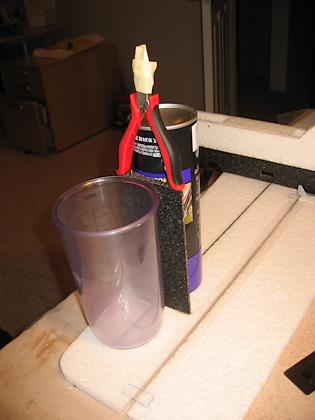 | ||||||||||||||||||||||||||||||||||||||||||||||||||||||||||||||||||||||||||||||||||||||||||||||||||||||||||||||||||||||||||||||||||||||||
| Next are the wing supports (struts). An aluminum wire is pushed through the strut to give it additional stability. It was a very tactile experience threading it through the middle of the strut! | The the support is glued to the bottom wing. I use a spray can to make sure that it is vertical and a pliers to weigh it down while the epoxy sets. Repeat on the other side :-) | ||||||||||||||||||||||||||||||||||||||||||||||||||||||||||||||||||||||||||||||||||||||||||||||||||||||||||||||||||||||||||||||||||||||||
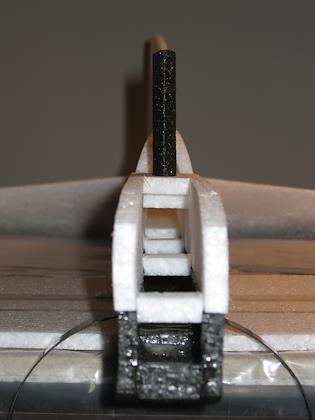 | 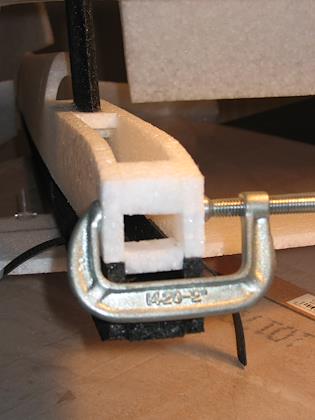 | ||||||||||||||||||||||||||||||||||||||||||||||||||||||||||||||||||||||||||||||||||||||||||||||||||||||||||||||||||||||||||||||||||||||||
| Here is the, shorter, center strut. You can see how the surface it is to be mounted on is sloped to the right. Fortunately, the face of the strut happens to be angled just the right amount to counter the slope of the fuselage. Lucky coincidence! Also, the first time I epoxied this piece in place, I put it about 2cm too far back! Luckily, I caught it in time to be able to carefully remove it and reglue in in its proper place! | Here I epoxy in the remaining nose piece. I made it extra thick to provide additional support. | ||||||||||||||||||||||||||||||||||||||||||||||||||||||||||||||||||||||||||||||||||||||||||||||||||||||||||||||||||||||||||||||||||||||||
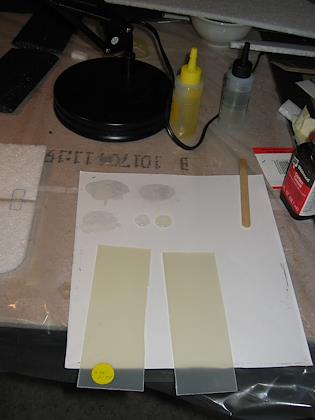 | 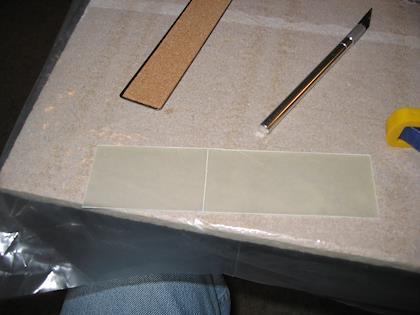 | ||||||||||||||||||||||||||||||||||||||||||||||||||||||||||||||||||||||||||||||||||||||||||||||||||||||||||||||||||||||||||||||||||||||||
| I want to be able to easily replace the motor, so I am making my own firewall. I found it remarkably difficult to obtain fiberglass laminate board with a thickness of 0.04 inches, which is the thickness of the firewall which came with the kit. However, I found a supply of 0.02 inch laminate which I will epoxy together to form a stronger piece. | I found the 0.02" laminate very easy to work with, I just score it with a blade and cleanly break it to make the pieces I want. | ||||||||||||||||||||||||||||||||||||||||||||||||||||||||||||||||||||||||||||||||||||||||||||||||||||||||||||||||||||||||||||||||||||||||
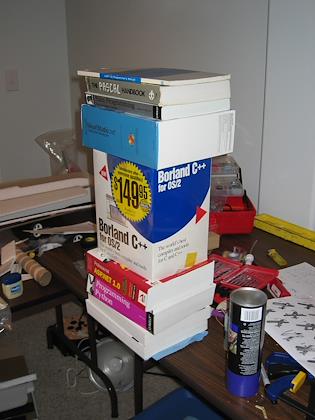 | 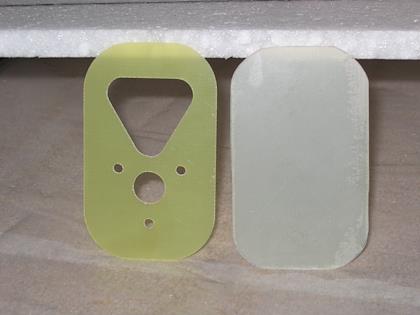 | ||||||||||||||||||||||||||||||||||||||||||||||||||||||||||||||||||||||||||||||||||||||||||||||||||||||||||||||||||||||||||||||||||||||||
| Letting the two pieces set. I helped produce Borland C++ for OS/2. Makes for a great weight now :-) | Here is the original, and next to it, the piece I made. I used a dremel tool to smooth the edges. | ||||||||||||||||||||||||||||||||||||||||||||||||||||||||||||||||||||||||||||||||||||||||||||||||||||||||||||||||||||||||||||||||||||||||
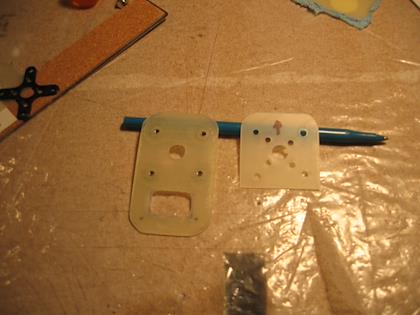 | 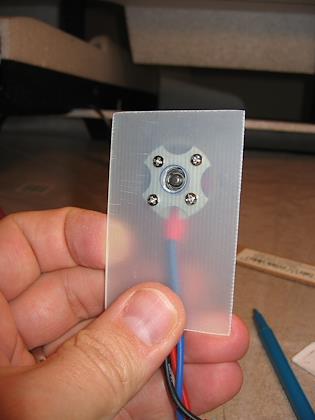 | ||||||||||||||||||||||||||||||||||||||||||||||||||||||||||||||||||||||||||||||||||||||||||||||||||||||||||||||||||||||||||||||||||||||||
| The motor mounts in a separate piece of laminate, at the right, which then bolts on to the firewall. | 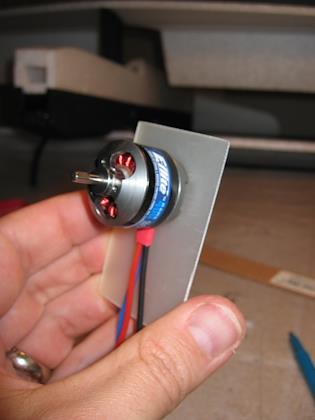 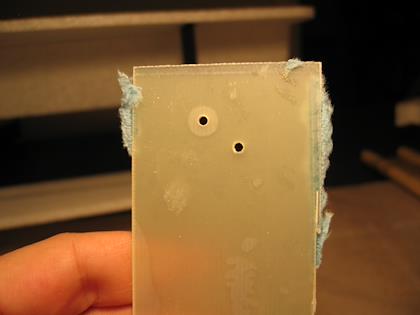 Here is a test piece. Notice the lighter part around the left hole. This was caused by drilling too quickly. The drill bit torqued the local area around the hole and separated the two epoxied pieces. | 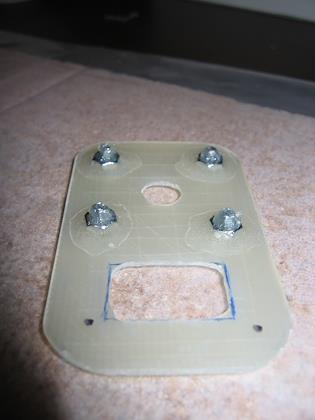  Here, I use Vaseline to coat the ends of the bolts so that when I sink them into the epoxy to mount the firewall to the nose, the epoxy will not attach to the bolts. | This is actually the second firewall plate I made. Three of the four bolts on the first piece were epoxied in place, even after I epoxied a test bolt which came out fine. Here I test the Vaseline approach. | 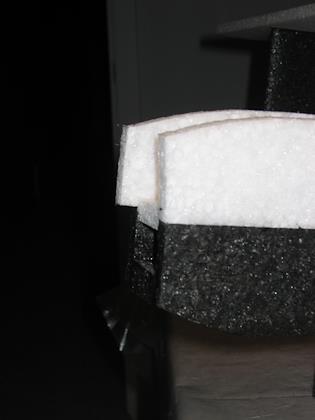 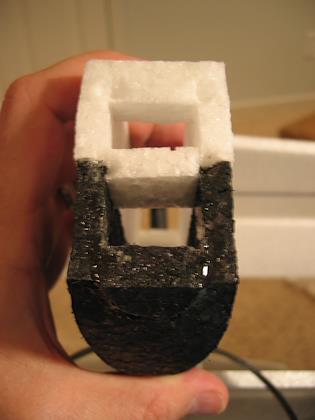 The top part of the fuselage was longer than the bottom. Here I trim it and flatten the nose in order to recieve the firewall. | I had to dig out four holes in the foam in which the bolts would rest. | 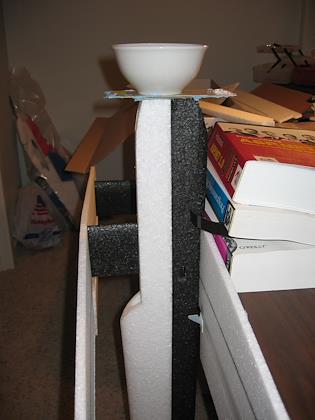 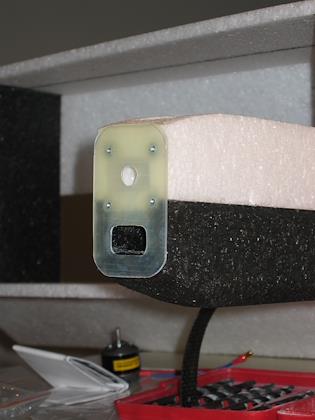 Getting creative with positioning the nose up to allow the epoxy to set. | The firewall in place! The bolts came out very easily; the Vaseline worked very well. A lot of time an effort went in to making this part of the plane! |  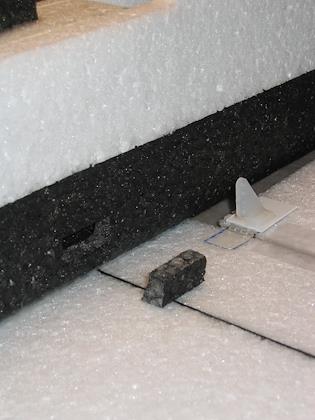 With the motor attached. | I decided to relocate the holes for the aileron servos so that that control arm would be more perpendicular to the control horn. I saved the original pieces and simply epoxied them back into place. | 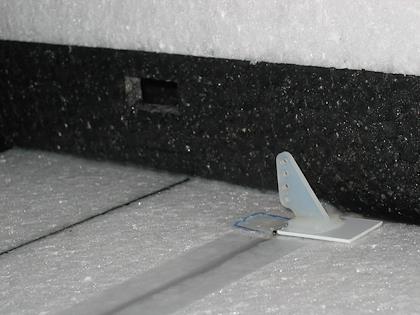 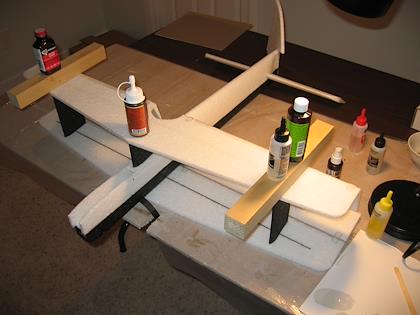 The new holes are higher up. The servo arm will point down. | Here I epoxy the upper wing on to the supports. |  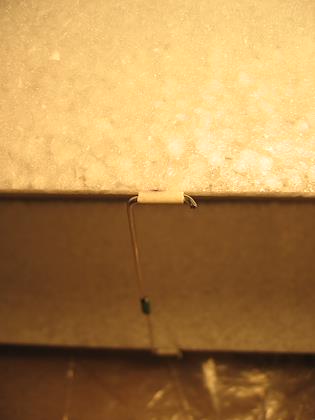 I cut slots into my work surface so I could gain better access to the wing. I used a spray can to make sure the top wing was correctly aligned with the bottom wing. I simply place the can next to the bottom wing and adjusted the top wing to coincide with the edge of the can. | Instead of burying an anchor into the aileron, I epoxied tubes to the trailing edge and installed aluminum rods with Z-bends in them to keep the upper and lower ailerons in sync. |  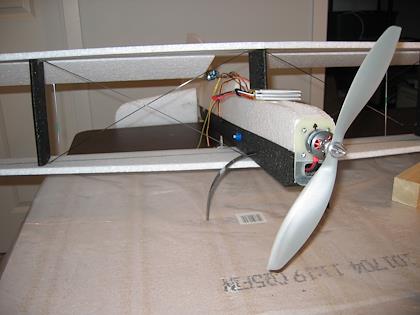 I have two separate pieces joined with some heat shrink tubing. After making sure the ailerons are perfectly aligned, I put a drop of CA at the joint to hold it. | The kit calls for a single brace for the wing box on each side, but the carbon rods supplied were rather flimsy and they would only support a force from the bottom of the wing. So, I installed two rods and joined them in the middle with kevlar thread and CA. | 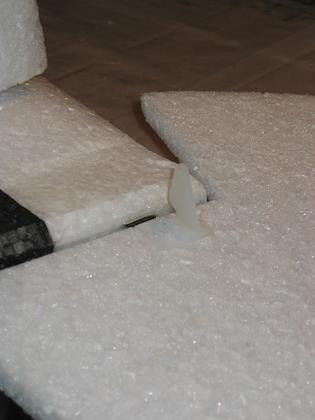 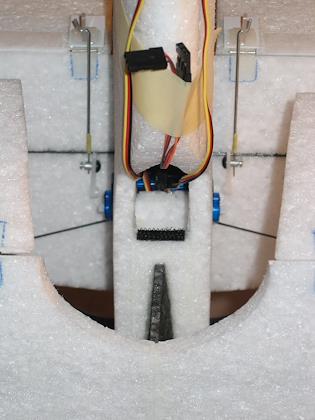 Now, I install a control horn for the rudder. | I will mount the receiver as far back as I can. All that extra epoxy has made it rather front heavy. Here I place a piece of velcro which will mate with ... | 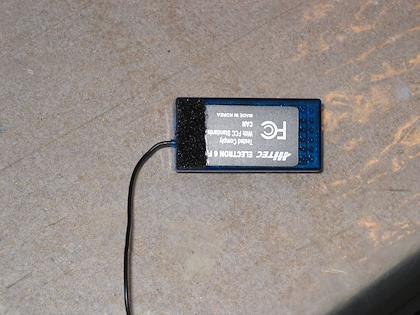 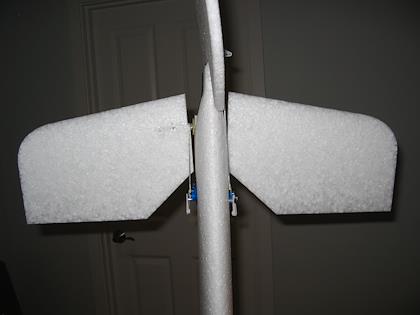 ... with the piece on the receiver. | The tail servos are mounted far back for the same reason. | 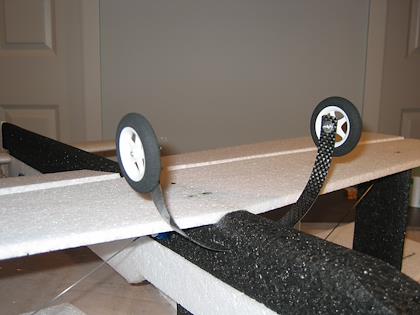 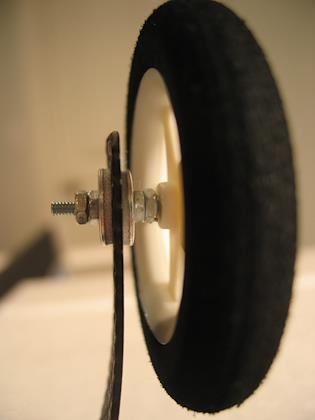 Then I attach the wheels. I'm using larger wheels than the kit came with. This should make it roll smoother on uneven surfaces. | In order to not stress the carbon fiber landing spring, I use washers to distribute the pressure of the nuts. I CA the nuts together to make sure they do not come loose. I've had problems with other wheels. | 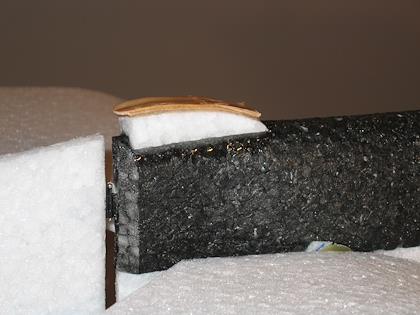  The tail skid. Seth glued a stick into the foam. I decided to use the skid the kit came with, and bend a popsicle stick around it for durability. | The complete plane weighs 15.5 ounces (with battery). Kinda on the heavy side. | 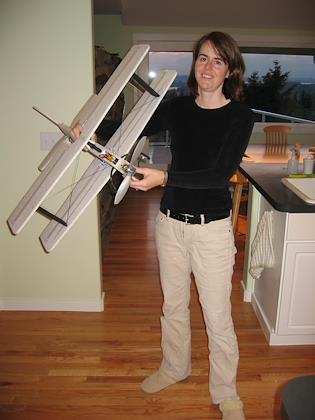 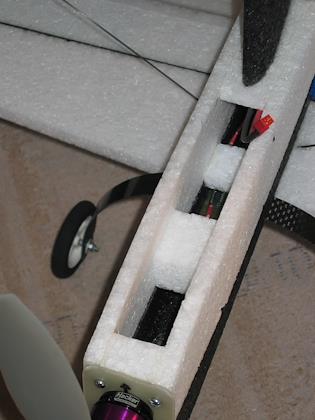 Sylvia models the plane! | Here I install a piece of foam to brace the front. This way I can pick it up from the front without squishing it. | 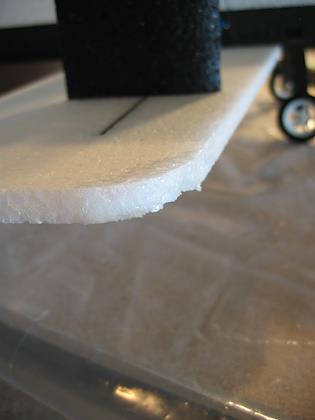  I had a rough landing (spectator distraction) and touch the leading edge of the wing on the ground. I applied some epoxy to these areas and the bottom of the rudder to keep the foam intact. | I also covered part of the opening here as well. On top of this near the center wing support, I fix a length of velcro for the batteries. | 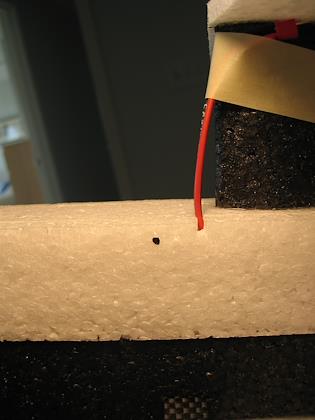 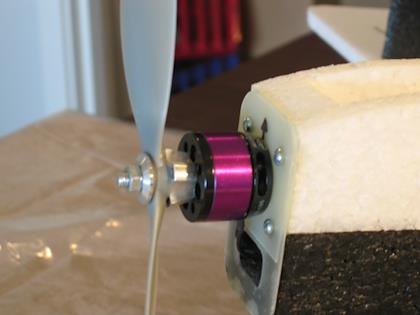 I cut a slot on the side where the battery connector comes out. | I changed out the motor to a Hacker A20-30M. Plenty of power and it seems more efficient than the Eflite 400 I was using. Plus it weighs less. | | |||||||||||||||||||||||||||||||||||||||||||||||||||||||||||||||||||||||||||||||||||||||||||||||||||||||||||